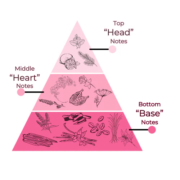The olfactory pyramid is a key concept in the perfumery world, used to describe the structure and evolution of a fragrance over time. This pyramid is divided into three levels: top notes, middle notes and base notes, each of which contributes to the personality of the fragrance in a distinct way. However, it is important to note that these notes do not necessarily correspond to the actual ingredients used in the composition of the fragrance, but rather to their perception over time.
The three stages of the olfactory pyramid
- Top notes: These are the first we perceive upon application of a perfume. They are fresh, light and volatile scents, such as citrus, herbs or marine notes. Top notes have a rather short duration, generally from a few minutes to half an hour. They are crucial in creating the first impression of a fragrance. In the case of Sauvage by Dior, top notes include bergamot of Calabria, which gives an immediate and vibrant freshness.
- Heart Notes: These notes emerge once the top notes have faded, usually within half an hour of application. Middle notes form the heart of the fragrance and last for several hours. They are rounder and more complex, often floral or spicy, and give depth to the fragrance. For example, in Lancôme’s La vie est belle, the heart notes are dominated by orange blossom, jasmine, and iris, giving an elegant and sophisticated character to the fragrance.
- Base notes: These are the last to be revealed and can last for many hours, even up to an entire day. Base notes are the most persistent and are often composed of ingredients such as woods, musks, vanilla or amber. These notes give the perfume solidity and staying power. In Dior’s Sauvage, the base notes include ambroxan, a synthetic compound derived from ambergris, which gives the fragrance a persistent, enveloping base.
History of the olfactory pyramid
The olfactory pyramid originated in the 19th century, when perfumers began to explore more scientifically the construction of fragrances. Before then, fragrances were often simpler blends with no defined structure. The pyramid was designed to represent the duration and perception of different olfactory molecules over time, thus facilitating the creation of more sophisticated scents. Thanks to this innovation, perfumers could balance compositions and modulate the evolution of the scent from the first application to the last traces.
Notes vs ingredients
An interesting aspect of the olfactory pyramid is that “notes” are not necessarily synonymous with the ingredients used in the fragrance. For example, the olfactory impression of a citrus top note might not be derived solely from bergamot or lemon, but also from a combination of synthetic molecules or other ingredients that replicate citrus freshness. Similarly, a woody base note might be created not only with natural woods such as cedar, but also with the use of synthetic molecules that mimic or amplify that sensation.
In this sense, the notes represent the olfactory effect we perceive, rather than just a list of raw materials. This allows perfumers great creative flexibility in constructing complex and unique fragrances.
Examples of olfactory pyramids
- Sauvage by Dior: Its pyramid opens with fresh top notes of Calabrian bergamot, followed by a spicy heart of pepper and geranium. The base notes are enveloping and include ambroxan, which gives depth and persistence.
- La vie est belle by Lancôme: This fragrance opens with sweet, fruity notes of pear and blackcurrant. The heart is composed of orange blossom, jasmine and iris, creating an elegant floral bouquet. The base notes, with patchouli, vanilla, and praline, add a warm, enveloping sweetness.
The olfactory pyramid remains an essential reference point for understanding the evolution and longevity of a fragrance, making each fragrance a multisensory journey that reveals itself over time.


